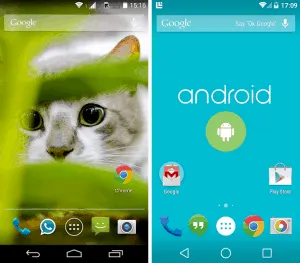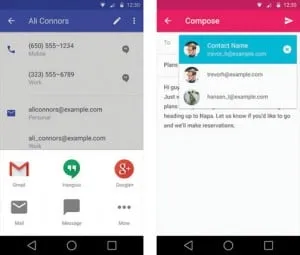Android 5.0 Lollipop
Google recently announced a new version of Android,
which by the looks of it, seems far more tastier than ever before.
Called the Android Lollipop 5.0, the new OS is expected to address all
shortcomings of the previous versions, which users have been complaining
about, including security issues. It’s not available yet, but Lollipop
is expected to take the user experience to the next level, while
improving the performance multi-fold. Will it be worth an upgrade, and
the bigger question, will it be available on all the devices out there?
Let’s take a closer look.
Sugar Rich FeaturesThe new fresh look - It gets the new Material Design with over 5,000 new APIs ticking away behind the scenes. The colorful, bold and responsive UI is expected to offer consistent, intuitive experiences across all devices.
Animated touch object - Touch will get animation, so when you touch an icon, it animates with objects flying into view and tapped icons rippling like puddle.

Easy to navigate - It will have more realistic lighting and shadows, responsive, natural motion and familiar visual elements, which would make it easier to navigate your device. Vivid new colors, typography and edge-to-edge imagery will help you to focus your attention.
Smarter Android - The new version will allow you to control the notification system. You can decide when and how you want to receive messages/ notifications.
Response mechanism on the lock screen - You will be able to view and respond to received messages directly from the lock screen, without publicizing your sensitive messages. It has the ability to hide sensitive content.
Fewer disruption - If you don’t want to be disturbed, then turn on the Priority mode via your device’s volume button so that only certain people and notifications get through. Or schedule recurring downtime like 10pm to 8am when only Priority notifications can get through.

Interruption free entertainment - Android Lollipop gives you the freedom to enjoy videos without getting interrupted. If you receive a call, it will show you a notification to choose to answer the call or just keep doing what you’re doing.
Age-long battery life - Play with your device for a longer time as it comes with a battery saver feature which extends device use by up to 90 minutes.
Flexibility to share the device - One device can be used by several users. Lollipop allows you to share the device with your friends and family with multiple user access for the phone.
Share your device, not the stuffs - Guest users have limited access to the phones or tablets.
Handy controls and settings - Quick settings enables you to make changes in the most frequently used settings with just two swipes down from the top of the screen. And it gets handy controls to flashlight, hotspot, screen rotation and cast screen.

High connectivity - It comes with improved network handoffs resulting in limited interruption in connectivity. As well as improved network selection logic enables users to connect the device only if there is a verified internet connection on Wi-Fi available.
Amazing Audio - Real-time audio experience with multi-channel audio stream mixing, so you get professional audio applications that can mix up to eight channels including 5.1 and 7.1 channels. Plug in USB microphones, speakers, and a myriad of other USB audio devices like amplifiers and mixers into your Android device as it comes with USB audio support.
Rich graphics - Lollipop gets OpenGL ES 3.1 and Android extension pack that brings the forefront of mobile graphics at par with the desktop and console class performance.

Professional photography features - It is packed with a bunch of new professional photography features that let you capture full resolution frames around 30 fps, support raw formats like YUV and Bayer RAW, control capture settings for the sensor, lens, and flash per individual frame and capture metadata like noise models and optical information.
Play UHD 4K videos on your device - State-of-the-art video technology with support for HEVC that allows you to play UHD 4K video. Convert your living room into a smart zone Android TV is integrated into Lollipop that supports living room devices and allows you to get games, videos, photos, TV shows etc. onto your big screen.
It also allows voice search for Google Play, YouTube and supported apps so you can just say what you want to see.
Slicker multitasking - Lollipop comes with the all-new 3D card-style view that fosters multitasking with ease. Flick through different apps, like a virtual Rolodex.
Devices That Get Android L Update First
Moto G or Moto X (all generations) and Moto E will get Lollipop update later this year. Sony Xperia Z range will get the update from Google. HTC One M8 or M7 will get the update within 90 days of getting the final version of Android L from Google and then later on other ‘One’ smartphones will get the update.
There is no official announcement yet from Samsung, but it is expected that all current Galaxy smartphones will be updated, though according to a tweet from the firm, the Galaxy Note 4 will get the update. LG commented on their German Facebook page that G3 and G2 will get the update. Meanwhile, the G Pad 8.3 will be updated alongside Google’s own Nexus range.
How secure is the new Android Lollipop?
Google has put a lot of effort into addressing the Android user security. The biggest roadblock to mobile device security is actually user apathy, which sees people skipping basic security practices like implementing a lock screen pin code.
Some new Lock methodology
Smart Accessibility: Lollipop offers Smart Lock that allows you to use paired devices to access your device without requiring a password or other means of authentication. You can set it up by using any NFC or Bluetooth-enabled device that has been paired with your Android L smartphone or tablet. The pairing requirement adds a layer of security, meaning your smartphone won’t unlock if you happen to be near an NFC terminal you’ve used for an in-store payment some time in the past.
Face unlock: Google’s face unlock analyzes user’s image continuously, as more of a background security process than a device unlocking mechanism. It captures minor changes in the facial looks, e.g. a moustache or a beard.
Automatic whole phone’s data encryption - In Lollipop, when you power on a new smartphone or tablet, it encrypts all data automatically, and creates a unique key that remains on the device to decrypt the data. It’s enabled by default, at the beginning of device set-up.
Enhanced security with SELinux - By using Security Enhanced Linux (SELinux), Google is enabling even further clarity around the isolation of individual apps. This means that users have to worry less about apps containing vulnerabilities that allow them to read info from other apps.
The unmatched performance of Android L
Google promises that the new version would offer a faster, smoother and more powerful computing experience. “ART’, an entirely new Android runtime, improves application performance and responsiveness. With this, devices’ performance would increase by up to 4x. Users would experience smoother UI with it. It is compacting background apps and services so that you can do more at once. Visually rich OS supports 64-bit devices like the Nexus 9, 64-bit SoCs using ARM, x86, and MIPS-based cores, shipping 64-bit native apps like Chrome, Gmail, Calendar, Google Play Music, etc. and pure Java language apps would run as 64-bit apps automatically on it.
.svg.png)